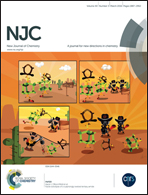Electrical conductivity and acetaldehyde vapour sensing studies on synthetic polypyrrole–titanium(iv)sulphosalicylophosphate nanocomposite cation exchange material
Abstract
In the present study, a novel electrically conductive polypyrrole–titanium(IV)sulphosalicylophosphate (PPy–TSCP) cation exchange nanocomposite was synthesized by an in situ chemical oxidative polymerization of pyrrole in the presence of titanium(IV)sulphosalicylophosphate (TSCP). The PPy–TSCP cation exchange nanocomposite was characterized by various instrumentation techniques such as FTIR, FE-SEM, XRD, TGA, DTA, DTG and EDXA. The composite exhibited good ion-exchange capacity (IEC) (2.10 meq g−1) as well as electrical conductivity (0.756 S cm−1) and isothermal stability in terms of DC electrical conductivity retention under ambient conditions up to 100 °C. The PPy–TSCP cation exchange nanocomposite based sensor was fabricated for the detection of acetaldehyde vapours, and it was found that the resistivity of the nanocomposite increases on exposure to a high concentration of acetaldehyde vapors at room temperature (25 °C). The rate of reaction for acetaldehyde vapour sensing on PPy–TSCP was observed to be first order.


 Please wait while we load your content...
Please wait while we load your content...